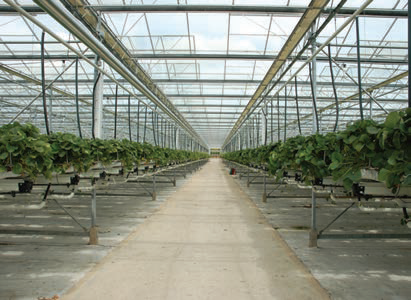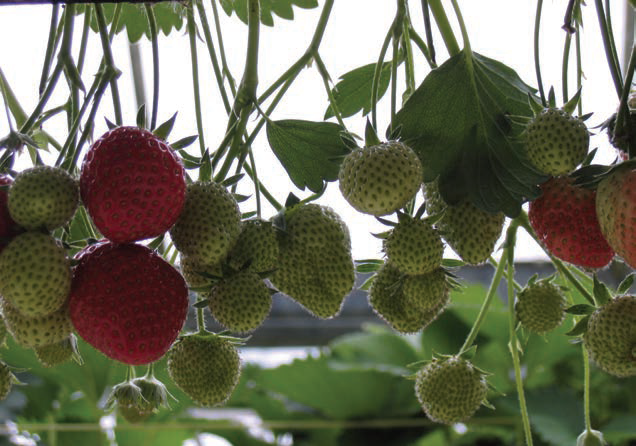Dr. Eamonn Kehoe, Teagasc Soft Fruit Specialist provides a review of the present situation in the Irish soft fruit industry and its challenges and prospects for the future.
Strawberry production
The main soft fruit crop grown in Ireland is strawberries. In the 1970s and ‘80s, this crop consisted mostly of processing strawberries. This has been offset today by a huge increase in protected fresh strawberry production.
At present, we produce about 7,000 tonnes of fresh strawberries per year. This is worth an estimated €37m. The Dutch cultivar ‘Elsanta’ is still the most popular cultivar grown. This is followed by a number of other cultivars including ‘Sonata’, ‘Clery’ and ‘Capri’. The cultivar ‘Malling Centenary’ is the most recent cultivar to be tried here. This was bred by the famous East Malling fruit research centre in East Malling, Kent, and named to celebrate 100 years of fruit research at the centre. So far it has proven very popular. This is especially due to its high-quality attributes.
Protected strawberry production is now the mainstay of Ireland’s soft fruit industry. The area of glasshouses built for protected strawberry production has increased substantially since the turn of the new millennium, and the expansion continues every year.
One of the main advantages of protective cropping is that it allows for the supply of fruit outside of the traditional short season of June to July. In fact, today strawberries are now supplied from late March right up until November. Fruit quality is also much higher, which is demanded by today’s consumer. Protective cropping also allows fruit to be harvested in unfavorable weather, giving pickers a much more comfortable environment to work in.
Table top systems
Most protected strawberry crops are grown in the substrate (peat or coco peat) filled bags or containers, placed on top of what is known in the trade as ‘table top’ systems. These are essentially steel frames or gutters, which are either raised off the ground or suspended from roof supports. This allows for much better crop management and makes picking much faster and easier, leading to major increases in efficiency and productivity.
The use of such substrates production has led to great flexibility in strawberry cropping, making it possible to grow strawberries nationwide. However, higher sunlight levels in the eastern and southeastern half of the country allow for earlier cropping, which gives a big competitive advantage.

Cane and bush fruit crops
The most popular cane fruit crop grown in Ireland is the raspberry. The Scottish bred cultivar ‘Glen Ample’ and ‘Tulameen’ from British Columbia are famous for their high-quality taste. To achieve the best standard they must be grown under glass or plastic protective cover.
With regard to blueberries, there may be potential for a high percentage of import substitution here. According to Bord Bía figures, at least €25m worth of blueberries was sold in Ireland in 2015. The vast majority of these were imported.
The first pioneering research on blueberries was undertaken by in the mid-1950s by the late Dr. Keith Lamb at An Foras Talúntais/The Agricultural Institute (AFT) at Johnstown Castle in County Wexford.
Due to the recent popularity of this fruit especially over the last five years, growers have taken a renewed interest in it. Some have opted to grow in containers and some in the ameliorated soil. The crop requires a very low pH (4.5 to 5.5) so maintenance of this pH is vital for successful crop growth.
Other minor cane fruit crops are also grown in Ireland, including blackberries, loganberries and tayberries, to mention just a few.
Major challenges
The biggest challenge for the soft fruit sector is control of labour costs, which in some cases are up to 50% of the total business costs. Any method of reducing these labour costs would be of major benefit. Because of the large
share of labour costs, growers will choose innovations which are more labour saving,
Technological advances are such that in some case, worker productivity is being doubled. One example of this is the development of a new robotic strawberry harvester called ‘Agrobot’ developed in Huelva, Spain. This machine reduces the labour need from 10 to two pickers per hectare. Many other automations have been made including the use of more efficient spraying systems and potting and filling machines.
New technology is continually being introduced into managing more efficient and productive crop growth. Not only are glasshouses fully automated and climate controlled but also the degree of automation is becoming increasingly specialised. New work on soil moisture sensors to irrigation and nutrition are being developed. Growers can even monitor environmental conditions in their glasshouses on their mobile phones, from almost anywhere. The use of artificial intelligence in control systems is only a matter of time. All of these new technologies should be used to complement the grower effort and not control it.
Price Squeeze
Growers operate in a commodity market. The markets are tough and competition is relentless; the only way to survive is to focus on efficiency, efficiency and more efficiency.
At the moment growers operate in an oligopsony (too few buyers and too many sellers). This is not a healthy position for a grower to be in as the buyers have too much pricing power. A rebalancing of pricing power may lead to a better and more stable pricing regime. This is up to industry to sort out.
Sustainability
There is always the need to balance economic considerations with environmental and social ones. We need to protect our environment for future generations. With this in mind, there will be more control over the use of resources like water and fertilisers for example. Many growers already have systems in place to recycle and reuse water and fertiliser leachate.
The use of Integrated Pest Management (IPM) and Decision Support Systems (DSS ) are increasing. The aim is to use pesticides needed, in a very timely and targeted way. With regards to the use of substrates (e.g. peat and cocoa peat) future emphasis may be on crops produced in more sustainable substrates. Cocoa peat, for example, comes over 9,000 km from Sri Lanka. There is a need to investigate the suitability of other media for strawberry production, such as bark, wood pulp etc.
Future opportunities
There are always niche opportunities for new growers. This very much depends on whether you can identify an opportunity in your local area and/or in a specific soft fruit crop. You need to do your research and have a good strategy. In your strategy think ‘local’ first. You must dominate a local market before you can even contemplate taking on a national market. I can provide you with the technical and financial advice in getting your soft fruit
business off the ground. ✽
  |











